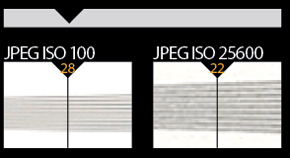Noise, Resolution and Sensitivity

We have tested numerous cameras with 16.3-million-pixel sensors, and the Fujifilm X-Pro1 is among the best. This camera can record a staggering amount of detail, as can be seen in our test chart resolution images, and it clearly benefits from the lack of low-pass filter.
When viewing the very tip of the test chart, it looks like the camera can resolve all the lines, but closer inspection reveals that while there are indeed some solid lines visible, there are just five instead of nine. That said, there is still an impression of detail where there would just be a blur when photographed with other cameras. In fact, when the X-Pro1 is combined with the 60mm macro lens, the detail resolution is on a par with an 18-million-pixel camera.
Noise is well controlled in JPEG images. At ISO 6400 there is a hint of luminance noise, but the X-Pro1 is as good as, if not better than, most other 16-million-pixel models. Colour noise is virtually non-existent at all ISO settings, although there is a decrease in colour saturation that would suggest a fair amount of colour noise removal has taken place.
The raw files obviously show more luminance and colour noise, but this is easy to reduce. Tweaking the contrast and sharpness of raw files reveals even more detail, and the 16.3-million-pixel sensor produces some of the most detailed images we have seen from an APS-C-sized unit.

These images show 72ppi (100% on a computer screen) sections of images of a resolution chart, captured using a Fujinon XF 60mm f/2.4 Macro lens. We show the section of the resolution chart where the camera starts to fail to reproduce the lines separately. The higher the number visible in these images, the better the camera’s detail resolution is at the specified sensitivity setting.




